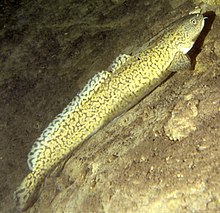Lota lota
| Burbot | |
|---|---|
 |
|
| Scientific classification | |
| Kingdom: | Animalia |
| Phylum: | Chordata |
| Class: | Actinopterygii |
| Order: | Gadiformes |
| Family: | Lotidae |
| Genus: |
Lota Oken, 1817 |
| Species: | L. lota |
| Binomial name | |
|
Lota lota (Linnaeus, 1758) |
|
The burbot (Lota lota) is the only gadiform (cod-like) freshwater fish. It is also known as bubbot,mariah, freshwater ling, the lawyer, coney-fish, lingcod,freshwater cusk, and eelpout. The species is closely related to the marine common ling and the cusk. It is the only member of the genus Lota. For some time of the year, the burbot lives under ice, and they require frigid temperatures to breed.
The name burbot comes from the Latin word barba, meaning beard, referring to its single chin whisker, or barbel. The generic and specific name lota comes from the old Frenchlotte fish named also "barbot" in Old French. The Inuktitut–Iñupiaq word for burbot was also used to name the recently discovered extinct presumed transitional species Tiktaalik.
With an appearance like a cross between a catfish and an eel, the burbot has a serpent-like body, but is easily distinguished by a single barbel on the chin. The body is elongated and laterally compressed, with a flattened head and single tube-like projection for each nostril. The mouth is wide, with both upper and lower jaws consisting of many small teeth. Burbot have two soft dorsal fins; the first being low and short, and the second being much longer. The anal fin is low and almost as long as the dorsal fin. The caudal fin is rounded, the pectoral fins are fan-shaped, and pelvic fins are narrow with an elongated second fin ray. Having such small fins relative to body size indicates a benthic lifestyle with low swimming endurance, unable to withstand strong currents.
Burbot have circumpolar distribution above 40°N. Populations are continuous from the British Isles across Europe and Asia to the Bering Strait. In North America, burbot range from the Seward Peninsula in Alaska to New Brunswick along the Atlantic coast. Burbot are most common in streams and lakes of North America and Europe. They are fairly common in Lake Erie, but are also found in the other Great Lakes. Recent genetic analysis suggests the geographic pattern of burbot may indicate multiple species or subspecies, making this single taxon somewhat misleading.
...
Wikipedia

